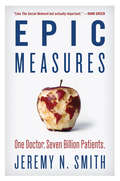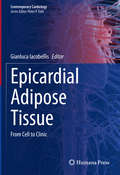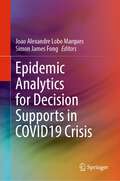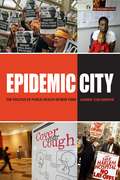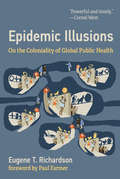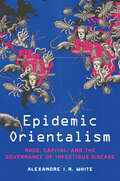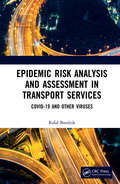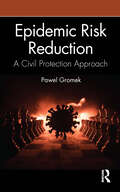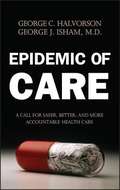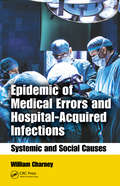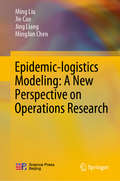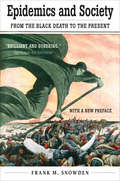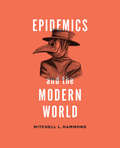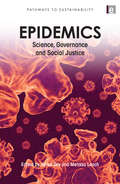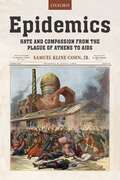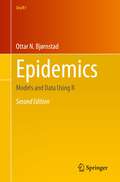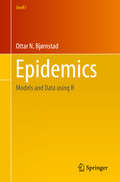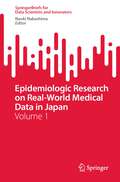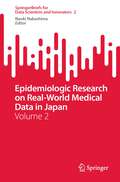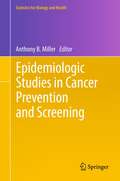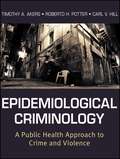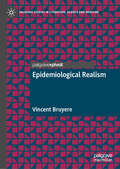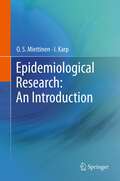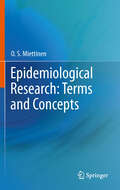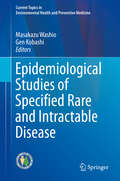- Table View
- List View
Epic Measures: One Doctor. Seven Billion Patients.
by Jeremy N. SmithMoneyball meets medicine in this remarkable chronicle of one of the greatest scientific quests of our time and the visionary mastermind behind it.Medical doctor and economist Christopher Murray began the Global Burden of Disease study to gain a truer understanding of how we live and how we die. While it is one of the largest scientific projects ever attempted—as breathtaking as the first moon landing or the Human Genome Project—the questions it answers are meaningful for every one of us: What are the world's health problems? Who do they hurt? How much? Where? Why?Murray argues that the ideal existence isn't simply the longest, but the one lived well and with the least illness. Until we can accurately measure global health issues, we cannot understand what makes us sick or do much to improve it. Challenging the accepted wisdom of the WHO and the UN, the charismatic and controversial health maverick has made enemies—as well as some influential friends, including Bill Gates who gave Murray a $100 million grant.Told with novelistic verve by acclaimed journalist Jeremy N. Smith, the story of Murray's lifelong determination to understand how we live and die encompasses wars and famines, presidents and activists, billionaires and billions of people worldwide living in poverty. It shows the human side of scientific revolutions and of revolutionary scientists—their breakthroughs and setbacks, their genius and their flaws, their champions and their critics—as they strive to bring the news of their findings to the world. This transformational effort is far from over, but the story of its genesis and impact is already an epic tale.
Epicardial Adipose Tissue: From Cell to Clinic (Contemporary Cardiology)
by Gianluca IacobellisThis book is the first authoritative and comprehensive volume dedicated to epicardial adipose tissue (EAT). It provides an up-to-date and highly illustrated synopsis of the anatomical, biomolecular, genetic, imaging features, and clinical applications of EAT and its role in cardiovascular disease.It relays to the reader a contemporary view of the emerging interplay between the heart and adiposity-related diseases. In addition, this volume discusses the clinical implications and therapeutic targets of EAT in atrial fibrillation, heart failure and coronary artery disease.Comprehensive yet focused, Epicardial Adipose Tissue: From Cell to Clinic is an essential resource for physicians, residents, fellows, and medical students in cardiology, endocrinology, primary care, and health promotion and disease prevention.
Epidemic Analytics for Decision Supports in COVID19 Crisis
by Simon James Fong Joao Alexandre Lobo MarquesCovid-19 has hit the world unprepared, as the deadliest pandemic of the century. Governments and authorities, as leaders and decision makers fighting against the virus, enormously tap on the power of AI and its data analytics models for urgent decision supports at the greatest efforts, ever seen from human history. This book showcases a collection of important data analytics models that were used during the epidemic, and discusses and compares their efficacy and limitations. Readers who from both healthcare industries and academia can gain unique insights on how data analytics models were designed and applied on epidemic data. Taking Covid-19 as a case study, readers especially those who are working in similar fields, would be better prepared in case a new wave of virus epidemic may arise again in the near future.
Epidemic City: The Politics of Public Health in New York
by James ColgroveAn insightful chronicle of the changing public health demands in New York City. The first permanent Board of Health in the United States was created in response to a cholera outbreak in New York City in 1866. By the mid-twentieth century, thanks to landmark achievements in vaccinations, medical data collection, and community health, the NYC Department of Health had become the nation’s gold standard for public health. However, as the city’s population grew in number and diversity, the department struggled to balance its efforts between the treatment of diseases—such as AIDS, tuberculosis, and West Nile Virus—and the prevention of illness-causing factors like lead paint, heroin addiction, homelessness, smoking, and unhealthy foods. In Epidemic City, historian of public health James Colgrove chronicles the challenges faced by the health department since New York City’s mid-twentieth-century “peak” in public health provision. This insightful volume draws on archival research and oral histories to examine how the provision of public health has adapted to the competing demands of diverse public needs, public perceptions, and political pressure. Epidemic City analyzes the perspectives and efforts of the people responsible for the city’s public health from the 1960s to the present—a time that brought new challenges, such as budget and staffing shortages, and new threats like bioterrorism. Faced with controversies such as needle exchange programs and AIDS reporting, the health department struggled to maintain a delicate balance between its primary focus on illness prevention and the need to ensure public and political support for its activities. In the past decade, after the 9/11 attacks and bioterrorism scares partially diverted public health efforts from illness prevention to threat response, Mayor Michael Bloomberg and Health Commissioner Thomas Frieden were still able to pass New York’s Clean Indoor Air Act restricting smoking and significant regulations on trans-fats used by restaurants. This legislation—preventative in nature much like the department’s original sanitary code—reflects a return to the nineteenth century roots of public health, when public health measures were often overtly paternalistic. The assertive laws conceived by Frieden and executed by Bloomberg demonstrate how far the mandate of public health can extend when backed by committed government officials. Epidemic City provides a compelling historical analysis of the individuals and groups tasked with negotiating the fine line between public health and political considerations. By examining the department’s successes and failures during the ambitious social programs of the 1960s, the fiscal crisis of the 1970s, the struggles with poverty and homelessness in the 1980s and 1990s, and in the post-9/11 era, Epidemic City shows how the NYC Department of Health has defined the role and scope of public health services for the entire nation.
Epidemic Illusions: On the Coloniality of Global Public Health
by Eugene T RichardsonA physician-anthropologist explores how public health practices--from epidemiological modeling to outbreak containment--help perpetuate global inequities.In Epidemic Illusions, Eugene Richardson, a physician and an anthropologist, contends that public health practices--from epidemiological modeling and outbreak containment to Big Data and causal inference--play an essential role in perpetuating a range of global inequities. Drawing on postcolonial theory, medical anthropology, and critical science studies, Richardson demonstrates the ways in which the flagship discipline of epidemiology has been shaped by the colonial, racist, and patriarchal system that had its inception in 1492.
Epidemic Orientalism: Race, Capital, and the Governance of Infectious Disease
by Alexandre I. WhiteFor many residents of Western nations, COVID-19 was the first time they experienced the effects of an uncontrolled epidemic. This is in part due to a series of little-known regulations that have aimed to protect the global north from epidemic threats for the last two centuries, starting with International Sanitary Conferences in 1851 and culminating in the present with the International Health Regulations, which organize epidemic responses through the World Health Organization. Unlike other equity-focused global health initiatives, their mission—to establish "the maximum protections from infectious disease with the minimum effect on trade and traffic"—has remained the same since their founding. Using this as his starting point, Alexandre White reveals the Western capitalist interests, racism and xenophobia, and political power plays underpinning the regulatory efforts that came out of the project to manage the international spread of infectious disease. He examines how these regulations are formatted; how their framers conceive of epidemic spread; and the types of bodies and spaces it is suggested that these regulations map onto. Proposing a modified reinterpretation of Edward Said's concept of orientalism, White invites us to consider "epidemic orientalism" as a framework within which to explore the imperial and colonial roots of modern epidemic disease control.
Epidemic Risk Analysis and Assessment in Transport Services: COVID-19 and Other Viruses
by Rafał Burdzik"Accurate and fully explicit mathematical models and derivations make the proposed method truly universal irrespective of the geographical location and the kind of virus epidemic." Minvydas Ragulskis, Kaunas University of Technology, Lithuania The effects of a pandemic on public, personal and freight transport can be sudden and massive, and yet transport is vital to the functioning of an advanced economy and society. On the other hand, transport, due to social mobility, has a decisive influence on the speed and scope of epidemic spread. This book presents a complete methodology for assessing the hazards, and probability and risks of viral transmission on transport services, using as a detailed example the SARS-CoV-2 coronavirus pandemic. It gives proposals and recommendations for estimating human deaths caused by virus infection in transport. Significantly, it considers not only passenger transport but also freight transport, such as delivery or parcel services. The tools include a matrix of hazard assessment in various transportation services, with a methodology for estimating the probability of virus transmission through both droplets and surface contact. These allow estimation of the effects of infections and consequent epidemic risk in all kinds of transport services, including freight, and provide methods for forecasting and risk management which determine transport safety. Rafał Burdzik is a professor in the Faculty of Transport and Aviation Engineering at Silesian University of Technology, Poland, with more than 20 years of transport research experience.
Epidemic Risk Reduction: A Civil Protection Approach
by Pawel GromekEpidemic Risk Reduction: A Civil Protection Approach focuses on disaster risk reduction (DRR) relative to epidemic outbreak and the concept of civil protection and public safety. First and foremost, the primary role of public officials and agencies—including police, military, public health, and emergency management and response professionals—must be the safety and security the citizens. The book provides practical solutions and policies that can be enacted and instituted to protect human life and health as well as property and environment in the scope of human survival, providing essential services, and providing for peoples’ basic needs. The author examines epidemics as disasters, similar to natural hazards or other large-scale events that require planning, preparedness, mitigation, and response. The approach is unique in looking at tools for risk assessment and strategic planning formulated around civil protection measures as a means to reduce and mitigate risk. Often, preparedness and response planning is siloed with an epidemiological and medical response at the forefront. While absolutely important and essential, doing so—in conjunction with coordinated government efforts to provide necessary supplies, security, and logistics—is equally critical to meet the public’s needs and provide a coordinated response. Key Features: Examines the phenomenon of epidemics and hazards, explaining that they are often multi-hazard Provides public leaders with various considerations to meet the challenge of managing the complexity of various threat vectors Details universal terms and definitions—e.g., disaster, risk, and epidemic—using diagrams, illustrations, and analogies to clearly explain critical concepts Presents epidemic risk reduction strategies—based on the lead role that disaster, emergency management, and state/civil authorities need to play—focusing primarily on individual health and security Epidemic Risk Reduction: A Civil Protection Approach establishes a common language which will help in overcoming barriers for more coordinated efforts focused on epidemic management and operational response. While drawing on current research, and based on theoretical knowledge, the book also provides practical examples from around the world that look at real-world response efforts. This includes recommendations on how politicians, crisis response personnel, emergency planners, and public administrators and health professionals can better plan and prepare for future epidemics.
Epidemic of Care: A Call for Safer, Better, and More Accountable Health Care
by George C. Halvorson George J. IshamRecognizing a crisis in American health care, but rejecting any solutions that are not "market-based," Halvorson (chair and CEO, Kaiser Permanente) and Isham (chief health officer, HealthPartners) explore some of the reasons for rising health care costs (absolving the HMOs for any responsibility) and make suggestions for improving the situation. Their proposed system rests largely on promoting evidence- based care for physicians and transferring greater costs to patients to improve "efficiency."
Epidemic of Medical Errors and Hospital-Acquired Infections: Systemic and Social Causes
by William CharneyThis book explores the issues surrounding medical errors and examines the science behind possible solutions. It creates a more efficient dialogue that will produce a more systemic targeting of the causes of medical errors and HAIs. The author elucidates the problems, including the complex issues of money and ethics. He uses statistical data to build the case for systemic change and re-confirms that millions of procedures done without error is as an important measuring figure as are the numbers of mistakes.
Epidemic-logistics Modeling: A New Perspective on Operations Research
by Jing Liang Jie Cao Ming Liu MingJun ChenThis book is the first work to conduct the emergency logistics optimization problem under the epidemic environment (whether natural or man-made), which provides a new perspective for the application of optimization theory. In this book, the research methods involve epidemic dynamics, scenario-based emergency decision-making method, big data which combines the traditional and emerging technologies. The authors take epidemic outbreak as the research object and deeply integrate the epidemic spread model with the optimization model of emergency resource scheduling, which opens up a novel application area of operations research.
Epidemics and Society: From the Black Death to the Present (The Open Yale Courses Series)
by Frank M. SnowdenA wide-ranging study that illuminates the connection between epidemic diseases and societal change, from the Black Death to Ebola This sweeping exploration of the impact of epidemic diseases looks at how mass infectious outbreaks have shaped society, from the Black Death to today. In a clear and accessible style, Frank M. Snowden reveals the ways that diseases have not only influenced medical science and public health, but also transformed the arts, religion, intellectual history, and warfare. A multidisciplinary and comparative investigation of the medical and social history of the major epidemics, this volume touches on themes such as the evolution of medical therapy, plague literature, poverty, the environment, and mass hysteria. In addition to providing historical perspective on diseases such as smallpox, cholera, and tuberculosis, Snowden examines the fallout from recent epidemics such as HIV/AIDS, SARS, and Ebola and the question of the world’s preparedness for the next generation of diseases.
Epidemics and the Modern World
by Mitchell HammondEpidemics and the Modern World explores the relationships between epidemics and key themes in modern history. Our institutions, colonial structures, relationships to animals, and perceptions of suffering, sexuality, race, and disability have all shaped – and been shaped by – these significant medical events. This book uses "biographies" of epidemics such as plague, tuberculosis, and HIV/AIDS to explore the impact of disease on the development of modern societies from the fourteenth century to the present. Drawing on the most recent science of genetics, microbiology, and climatology, this text includes "Science Focus" boxes that discuss important scientific concepts and technologies. Structured workshop sections with engaging primary sources help readers develop skills of interpretation and gain knowledge of key historical events. Epidemics and the Modern World assumes no prior experience with the history of science or medicine and is accessible for undergraduate students, while its challenging approach to the history of the modern world will engage readers of all levels and all interests.
Epidemics: "Science, Governance and Social Justice"
by Sarah Dry Melissa LeachRecent disease events such as SARS, H1N1 and avian influenza, and haemorrhagic fevers have focussed policy and public concern as never before on epidemics and so-called 'emerging infectious diseases'. Understanding and responding to these often unpredictable events have become major challenges for local, national and international bodies. All too often, responses can become restricted by implicit assumptions about who or what is to blame that may not capture the dynamics and uncertainties at play in the multi-scale interactions of people, animals and microbes. As a result, policies intended to forestall epidemics may fail, and may even further threaten health, livelihoods and human rights. The book takes a unique approach by focusing on how different policy-makers, scientists, and local populations construct alternative narratives-accounts of the causes and appropriate responses to outbreaks- about epidemics at the global, national and local level. The contrast between emergency-oriented, top-down responses to what are perceived as potentially global outbreaks and longer-term approaches to diseases, such as AIDS, which may now be considered endemic, is highlighted. Case studies-on avian influenza, SARS, obesity, H1N1 influenza, HIV/AIDS, tuberculosis, and haemorrhagic fevers-cover a broad historical, geographical and biological range. As this book explores, it is often the most vulnerable members of a population-the poor, the social excluded and the already ill-who are likely to suffer most from epidemic diseases. At the same time, they may be less likely to benefit from responses that may be designed from a global perspective that neglects social, ecological and political conditions on the ground. This book aims to bring the focus back to these marginal populations to reveal the often unintended consequences of current policy responses to epidemics. Important implications emerge - for how epidemics are thought about and represented; for how surveillance and response is designed; and for whose knowledge and perspectives should be included. Published in association with the Economic and Social Research Council (ESRC)
Epidemics: Hate and Compassion from the Plague of Athens to AIDS
by Samuel K. CohnBy investigating thousands of descriptions of epidemics reaching back before the fifth-century-BCE Plague of Athens to the distrust and violence that erupted with Ebola in 2014, Epidemics challenges a dominant hypothesis in the study of epidemics, that invariably across time and space, epidemics provoked hatred, blaming of the 'other', and victimizing bearers of epidemic diseases, particularly when diseases were mysterious, without known cures or preventive measures, as with AIDS during the last two decades of the twentieth century. <p><p> However, scholars and public intellectuals, especially post-AIDS, have missed a fundamental aspect of the history of epidemics. Instead of sparking hatred and blame, this study traces epidemics' socio-psychological consequences across time and discovers a radically different picture: that epidemic diseases have more often unified societies across class, race, ethnicity, and religion, spurring self-sacrifice and compassion.
Epidemics: Models and Data Using R (Use R!)
by Ottar N. BjørnstadThis book is designed to be a practical study in infectious disease dynamics. It offers an easy-to-follow implementation and analysis of mathematical epidemiology. It focuses on recent case studies in order to explore various conceptual, mathematical, and statistical issues. The dynamics of infectious diseases shows a wide diversity of pattern. Some have locally persistent chains-of-transmission, others persist spatially in consumer-resource metapopulations. Some infections are prevalent among the young, some among the old and some are age-invariant. Temporally, some diseases have little variation in prevalence, some have predictable seasonal shifts and others exhibit violent epidemics that may be regular or irregular in their timing.Models and ‘models-with-data’ have proved invaluable for understanding and predicting this diversity, and thence help improve intervention and control. Using mathematical models to understand infectious disease, dynamics has a very rich history in epidemiology. The field has seen broad expansions of theories as well as a surge in real-life application of mathematics to dynamics and control of infectious disease. The chapters of Epidemics: Models and Data Using R have been organized as follows: chapters 1-10 is a mix and match of models, data and statistics pertaining to local disease dynamics; chapters 11-13 pertains to spatial and spatiotemporal dynamics; chapter 14 highlights similarities between the dynamics of infectious disease and parasitoid-host dynamics; Finally, chapters 15 and 16 overview additional statistical methodology useful in studies of infectious disease dynamics.This book can be used as a guide for working with data, models and ‘models-and-data’ to understand epidemics and infectious disease dynamics in space and time. All the code and data sets are distributed in the epimdr2 R package to facilitate the hands-on philosophy of the text.
Epidemics: Models and Data using R (Use R!)
by Ottar N. BjørnstadThis book is designed to be a practical study in infectious disease dynamics. The book offers an easy to follow implementation and analysis of mathematical epidemiology. The book focuses on recent case studies in order to explore various conceptual, mathematical, and statistical issues. The dynamics of infectious diseases shows a wide diversity of pattern. Some have locally persistent chains-of-transmission, others persist spatially in ‘consumer-resource metapopulations’. Some infections are prevalent among the young, some among the old and some are age-invariant. Temporally, some diseases have little variation in prevalence, some have predictable seasonal shifts and others exhibit violent epidemics that may be regular or irregular in their timing. Models and ‘models-with-data’ have proved invaluable for understanding and predicting this diversity, and thence help improve intervention and control. Using mathematical models to understand infectious disease dynamics has a very rich history in epidemiology. The field has seen broad expansions of theories as well as a surge in real-life application of mathematics to dynamics and control of infectious disease. The chapters of Epidemics: Models and Data using R have been organized in a reasonably logical way: Chapters 1-10 is a mix and match of models, data and statistics pertaining to local disease dynamics; Chapters 11-13 pertains to spatial and spatiotemporal dynamics; Chapter 14 highlights similarities between the dynamics of infectious disease and parasitoid-host dynamics; Finally, Chapters 15 and 16 overview additional statistical methodology useful in studies of infectious disease dynamics. This book can be used as a guide for working with data, models and ‘models-and-data’ to understand epidemics and infectious disease dynamics in space and time.
Epidemiologic Research on Real-World Medical Data in Japan: Volume 1 (SpringerBriefs for Data Scientists and Innovators #1)
by Naoki NakashimaThis book analyzes the development of medical big data projects in Japan.Japan is experiencing unprecedented population aging, and labor productivity has decreased accordingly. Big data analysis of the Japanese medical real-world database (RWD) has the potential to tackle this issue.To allow readers to gain an understanding of Japanese medical big data analysis, the book discusses the original Japanese system that generates medical RWDs in the hospital medical records system, the nationwide standardized health checkup system, and the public medical insurance system in Japan.After introducing four major big data projects in the healthcare–medical field in Japan, the book explains the importance of creating information standards to maintain data quality and to analyze medical big data. It enables readers to analyze which standards are installed in which RWDs, how the standards are maintained, and which issues are prevalent in Japan.This book also describes the ethical processes involved in big data projects involving medical RWDs in Japan.
Epidemiologic Research on Real-World Medical Data in Japan: Volume 2 (SpringerBriefs for Data Scientists and Innovators #2)
by Naoki NakashimaThis book analyzes the development of medical big data projects in Japan.Japan is experiencing unprecedented population aging, and labor productivity has decreased accordingly. Big data analysis of the Japanese medical real-world database (RWD) has the potential to tackle this issue.To allow readers to gain an understanding of Japanese medical big data analysis, the book discusses the original Japanese system that generates medical RWDs in the hospital medical records system, the nationwide standardized health checkup system, and the public medical insurance system in Japan.After introducing four major big data projects in the healthcare–medical field in Japan, the book explains the importance of creating information standards to maintain data quality and to analyze medical big data. It enables readers to analyze which standards are installed in which RWDs, how the standards are maintained, and which issues are prevalent in Japan.This book also describes the ethical processes involved in big data projects involving medical RWDs in Japan.
Epidemiologic Studies in Cancer Prevention and Screening
by Anthony B. MillerEpidemiologic Studies in Cancer Prevention and Screening is the first comprehensive overview of the evidence base for both cancer prevention and screening. This book is directed to the many professionals in government, academia, public health and health care who need up to date information on the potential for reducing the impact of cancer, including physicians, nurses, epidemiologists, and research scientists. The main aim of the book is to provide a realistic appraisal of the evidence for both cancer prevention and cancer screening. In addition, the book provides an accounting of the extent programs based on available knowledge have impacted populations. It does this through: 1. Presentation of a rigorous and realistic evaluation of the evidence for population-based interventions in prevention of and screening for cancer, with particular relevance to those believed to be applicable now, or on the cusp of application 2. Evaluation of the relative contributions of prevention and screening 3. Discussion of how, within the health systems with which the authors are familiar, prevention and screening for cancer can be enhanced. Overview of the evidence base for cancer prevention and screening, as demonstrated in Epidemiologic Studies in Cancer Prevention and Screening, is critically important given current debates within the scientific community. Of the five components of cancer control, prevention, early detection (including screening) treatment, rehabilitation and palliative care, prevention is regarded as the most important. Yet the knowledge available to prevent many cancers is incomplete, and even if we know the main causal factors for a cancer, we often lack the understanding to put this knowledge into effect. Further, with the long natural history of most cancers, it could take many years to make an appreciable impact upon the incidence of the cancer. Because of these facts, many have come to believe that screening has the most potential for reduction of the burden of cancer. Yet, through trying to apply the knowledge gained on screening for cancer, the scientific community has recognized that screening can have major disadvantages and achieve little at substantial cost. This reduces the resources that are potentially available both for prevention and for treatment.
Epidemiological Criminology
by Timothy A. Akers Roberto H. Potter Carl V. HillEpidemiological Criminology: A Public Health Approach to Crime and Violence Epidemiological Criminology offers an introduction to the sources and methods of epidemiological criminology and shows how to apply these methods to some of the most vexing problems now confronting researchers and practitioners in public health epidemiology, criminology, and criminal justice. The book describes, explains, and applies the newly formulated practice of epidemiological criminology, an emerging discipline that finds the intersection across theories, methods, and statistical models of public health with their corresponding tools of criminal justice and criminology. The authors show how to apply epidemiological criminology as a practical tool to address population issues of violence and crime nationally and globally. In addition, they look at future directions and the application of this emerging field in corrections, public health and law, gangs and gang violence, victimology, mental health and substance abuse, environmental justice, international human rights, and global terrorism. For students, the book presents an exciting approach to understanding epidemiology as a means with which to tackle some of the worst problems for vulnerable populations. For researchers and policymakers, the book offers a new methodological perspective that recognizes the significance of social disparities and the built environment as factors in the formulation of public health policy, and provides a tool with which to produce more effective interventions, preventive measures, and policy formulations.
Epidemiological Realism (Palgrave Studies in Literature, Science and Medicine)
by Vincent BruyereThis book examines what it means to live in an epidemiological reality, exploring the worldbuilding properties of epidemiology through the lens of critical theory, literary analysis, and visual culture. Whether we want it or not, we live in a world made of statistical correlations, risk factors, and social determinants of health, animal reservoirs and spillovers, containment strategies and curves to be flattened, prophylactic measures, and syndromic surveillance systems detecting in real-time potential outbreaks. This book uses a series of vignettes to show that we have lived in a version of that reality for quite some time now, even before the formalization of epidemiological tools and concepts at the beginning of the twentieth century.
Epidemiological Research: An Introduction
by O. S. Miettinen I. KarpHaving last year published "Up from Clinical Epidemiology & EBM" and also "Epidemiological Research: Terms and Concepts," Miettinen now - this time with collaboration from his junior colleague I. Karp - brings out this further introduction into epidemiological research; and he is now working on an introduction into clinical research, for publication next year. It evidently is Miettinen's felt time to crystallize the basic understandings he has come to as the culmination of a half-century of concentrated effort to advance the theory of epidemiological and 'meta-epidemiological clinical' research. In accord with its title, this book focuses on research to develop the knowledge-base for preventive medicine, which mainly is knowledge about the causal origin -etilogy, etiogenesis - of illness. It first illustrates how wanting this knowledge still is, despite much research; and it then aims to guide the reader to more productive etiogenetic research. This book places much emphasis on the need to assure relevance by principles-guided objects design for the studies, which now remains conspicuously absent from epidemiologists' concerns. And as for methods design, this book exposes the fallacies in the still-common 'cohort' and 'case-control' studies, defines the essentials of all etiogenetic studies, and then addresses the true options for design in this framework of shared essentials. A good deal of attention is also given to the still commonly-held, very major, twin fallacies that screening for an illness is a preventive intervention, to be studied by randomized trials, and that research on it can imply rational guidelines or recommendations regarding decisions about the screening. While Miettinen already is regarded as 'the father of modern epidemiology,' he now appears to have become the father also of post-modern epidemiology, where 'epidemiology' still means epidemiological research.
Epidemiological Research: Terms and Concepts
by O. S. MiettinenThis book addresses clinical and epidemiological topics of medicine and statistics; then topics of epidemiological research and finally,'meta-epidemiological' clinical research. The author offers a wealth of expertise acquired in a 50-year career in the field.
Epidemiological Studies of Specified Rare and Intractable Disease (Current Topics in Environmental Health and Preventive Medicine)
by Masakazu Washio Gen KobashiThis book presents research findings from epidemiological studies investigating chronic and intractable diseases with unidentifiable causes from a clinical perspective. Each chapter provides the latest findings on specific diseases, including procedures for their study, insights into their causes, risk factors and preventive factors providing a foundation for new ideas and further development as well as establishing treatment procedures. Epidemiological Studies of Specified Rare and Intractable Disease(Nanbyo in Japanese) is a valuable resource for both new and established researchers as well as students who are seeking information on public health and on environmental and clinical epidemiology.
